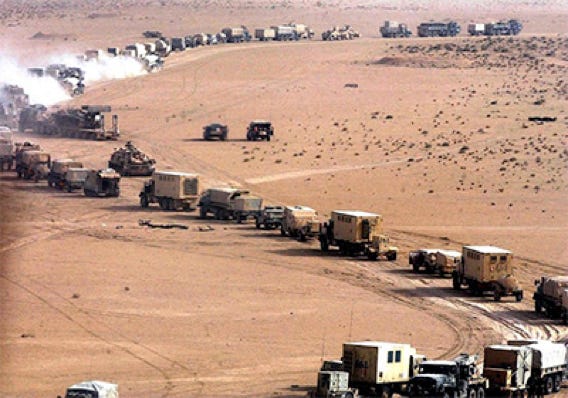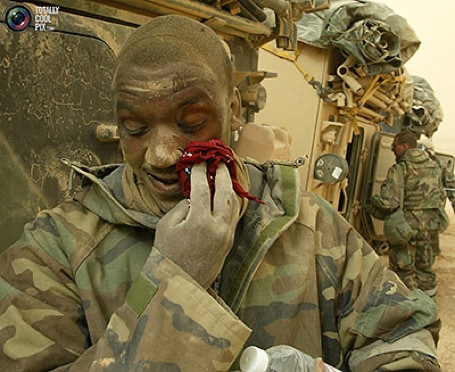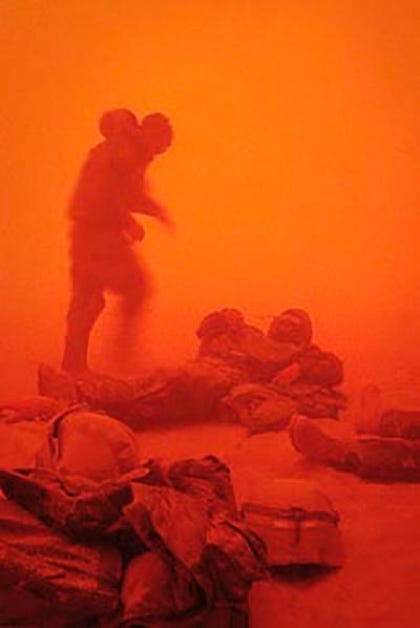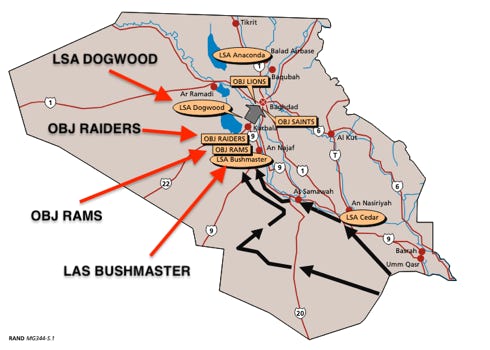Talking Proud: Service & Sacrifice
Logistics in the Iraq War: “A Herculean feat”
“Good generals study tactics. Great generals study logistics”
The Mother of all Duststorms
“Ochre dust and grit into every crevice”
The next challenge for the 3rd ID and its support columns was huge. From March 24 to 27, a hellacious sandstorm, known as the shamal or to the troops, the "mother of all storms," blew through Iraq for several days. It affected the progress of much of the invasion force. I’ve talked about this storm previously. Let’s look closer and imagine yourself and your rifle sitting in this thing.
Everything slowly turned a yellowish-orange color, decreasing visibility and dropping to 10 meters. Carl Drews wrote:
"Ochre dust and grit worked its way into every crevice of every weapon, garment, and vehicle."
In an interview with PBS Frontline, Lt. General Wallace, USA, the Army’s V Corps commander, commented this way:
"The weather really sucked. It's hard to describe. You could literally not see more than about 30 or 40 feet with your naked eye. The whole area was engulfed by this orangish, reddish haze. It looks like one of these old science fiction movies of folks walking around the surface of Mars. I mean, there's just red haze, and then it started raining. And because of all the particles suspended in the air, as the rain hit the ground, it was actually a drop of mud, and it began to cake on the vehicles ...
"… The sandstorm hit at the same time the logistics base was needing to be built, and the sandstorm ... slowed down our convoys. ... I remember vividly a supply convoy from the Corps Support Command that had two days of supply of water and food for the 3rd Infantry Division, but it took them four days to get there. ... So the sandstorm was a low point in that it slowed us down; it slowed down our momentum and it slowed down our ability to build our logistics."
The 3rd ID crossed the line of departure on March 19, 2003, with only three days of supplies of water, food, and ammunition. General Wallace said the 3rd ID took five days. The dust storm began on March 24, so the 3rd ID was on its fifth day of operations. Whatever the case, the 3rd ID was perilously low on supplies.
Wallace said, "During that storm, our convoys took three to four days to reach our forward forces, and they were carrying two days of supplies.”
Furthermore, many combat units outside the 3rd ID had been fighting and were eating up their stocks.
General Wallace objected to the media reports that the force was in a “pause.” While the dust storm slowed down force movements, he argued that the troops were still operating at a high operational tempo and were involved in many fights. He agreed they were not gaining ground, but he said that had to be accepted because they had to secure those logistics lines for the full assault on Baghdad to be successful.
Wallace acknowledged that “the texture of the desert terrain” was a surprise, saying “the dust problem in those areas were orders of magnitude worse than any of our terrain analysts had predicted.” He said the dust slowed the convoys and shut down the air. He said, “Anything that moved out there, it kicked up a dust cloud. It was like driving through talcum powder.”
General Franks also commented on the storm:
"The big sandstorm was even worse than predicted. Reddish brown dust formed a high dome in the western desert and rolled over southern Iraq - and over 170,000 coalition troops. Visibility dropped to 10 meters or less. Rain pounded down through the red dust, turning the air to mud.
"Our long logistics convoys crawled ahead, however, eventually linking up with the armor and infantry units that were managing to creep forward during lulls in the sandstorm. And, as the troopers inched on, scouts and special forces reconnaissance teams infiltrated more Iraqi positions, identifying the precise GPS coordinates of enemy armor and artillery.”
As the sandstorm rose in intensity, movement on the battlefield virtually stopped. However, Lt. General Buzz Moseley, USAF, then the air component commander, and his staff came up with an idea. Yes, the Americans had slowed down and, in some instances, stopped. But so had the enemy, and the USAF controlled the skies. So, USAF B52s, B-1s, and a mix of fighter bombers flew above the dust storm and pummeled Republican Guard forces, which were stalled in place. Franks wrote:
"The Republican Guard units were hunkered down, and they were being destroyed piece by piece."
It’s now March 28, 2003. The 3rd ID transferred the responsibility for fighting in and around Najaf to the 101st ABN, enabling its forces to prepare for operations in Baghdad. The 3rd ID had already secured Objectives RAMS and RAIDERS. The dust storm inhibited logistics resupply, but the system was able to catch up, sort of. Combat forces secured the logistics lines from Kuwait to LSA BUSHMASTER. The dominant threats to these lines came more from irregular guerrilla-type forces than the Iraqi Army.
The demand for spare parts was not satisfied; demand was far greater than that experienced during exercises. Nearly all the requirements for spare parts went through the laborious national supply system back in the US. Initiating these requirements while immersed in battle was very difficult and, in some cases, did not happen. Truck shortages remained a serious problem. Thankfully, the Iraqi logistics system, if there was one, was not good at all.
The 3rd Squadron, 7th Cavalry Regiment (Mech) (3-7 Cav) was part of the 2nd Brigade, 3rd ID, and was to be the spearhead and screening force for the 3rd ID's main elements as it advanced.
The 3-7 Cav was tasked to clear and secure Najaf and deny enemy access to supply routes. It was in a very tough fight on March 25, 2003. The fight was such that the brass sent in forces from the north to help seal off the city. The troops experienced a high rate of fire and ran low for small arms. Needed ammunition was loaded aboard CH-47s, but the sandstorm prevented them from flying.
By the time the storm lifted, the CH-47s were no longer available. As a result, their support troops delivered the ammunition to an objective near Najaf, but the 3rd ID advances against Baghdad had already begun; once again, the battlefield dynamics. They would have to make do.
The Saga of the 4th Infantry Division
Click to zoom graphic-photo






